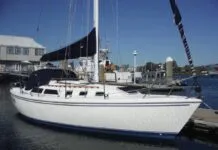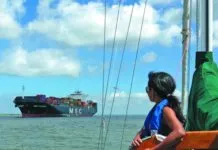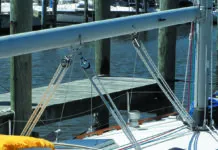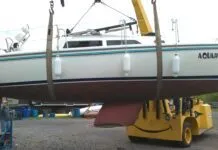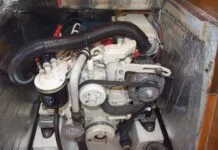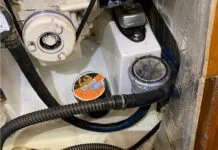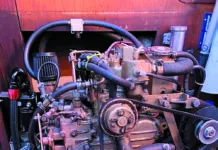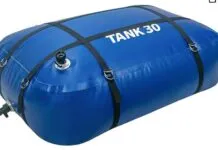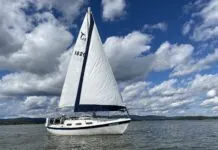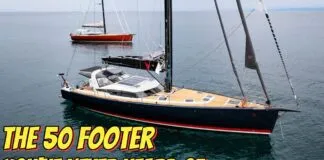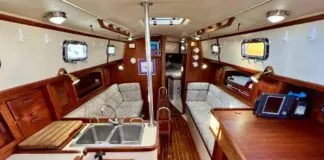Our attention was forcefully drawn to the subject of mooring chains when the chain anchoring our raft, the Foulbottom, parted in a storm, and we lost the raft along with its cargo of anti-fouling paint test panels. The chain was less than four years old. We were told by our local dockmaster that this wasnt an isolated incident. Despite a compulsory inspection of mooring rigs every three years, one or more boats in the harbor loses its mooring each year. Our decision to test different types of mooring chain didnt require a great deal of thought.
When we launched Foulbottom II-a bigger, stronger test bed for antifouling paints-we anchored it with no fewer than five 75-pound mushrooms, each with a different type of chain. To avoid difficulties with shackle failure we used stainless-steel swivels to connect the chains to the anchors. Upper shackles were normally well out of the water, and we used galvanized anchor shackles to attach each chain to the raft.
Five Chain Types Tested
Leafing through catalogs, we found five basic types of anchor chain: proof coil, BBB, high test, vinyl-coated proof coil and stainless steel proof coil; all except the stainless are zinc-coated use a hot-dip galvanizing process. The vinyl coating on the vinyl-coated chain is applied after the chain is galvanized. While chains with other protective coatings, such as electro-galvanizing and cadmium plating, are available, theyre generally unsuited for marine application, so we didnt test any of these.
Chain types are defined primarily by the length of the individual links. All our samples are open link; stud link is excellent but hard to find in the right sizes for yachts. Proof coil chain is probably the most commonly used type for moorings, though its relatively long, open links may make it incompatible with with some anchor windlasses. The link design is shared with vinyl-covered proof coil chain and stainless-steel proof coil chain. BBB chain has thicker, shorter links. BBB chain is roughly 20% heavier than proof coil chain on a per-foot basis but doesn’t exhibit any improvement in tensile strength.
Proof coil chain, as well as its vinyl-covered sibling and BBB chain, is made of low-carbon steel-a tough, moderate-strength steel that tends to bend rather than break under severe load.
High test chain is made of a higher-carbon steel that gives it a higher strength/weight ratio than low-carbon steel. High test chain has slightly longer links than BBB chain. High test chain is about midway between proof coil and BBB in terms of strength for a given weight; its about 50% stronger than either of the others on a per-foot basis.
Most windlass manufacturers can match the wildcat to your chain, but check before buying.
Vinyl-coated chains main advantage? Its soft plastic coating wont mar a deck or gelcoat. Stainless Steel proof coil chain has the obvious advantage of not rusting. Its midway between proof coil and high test on a strength-per-foot basis; on a strength-per-pound basis (which is of relatively little importance in a mooring rode that doesn’t get handled often) its even stronger than high test.
A word about strength ratings. The strength of chain, like rope, is usually listed in two ways: breaking (or ultimate) strength, and working strength. The former is the load that will break a sample of new chain, in good condition, under laboratory conditions. Because chain, generally speaking, isn’t new, isn’t necessarily in good condition and is seldom used under laboratory conditions, a working load limit is also supplied. This figure, about 25-30% of the chains breaking strength, is the basis for selecting chain. Its not as conservative a derating factor as it appears: A chains ultimate strength is only a valid number if theres no rust or corrosion of the chain.
We were interested in finding which types of chain are best; not in a brand-by-brand comparison, because chain is among the items not generally purchased by brand name. We ordered all our chain samples from the same catalog. All the chains were manufactured by the same manufacturer, Acco. Because marine chains conform to ISO standards, wed expect other manufacturers products to behave similarly to the ones we tested.
Chains Checked Periodically
Our testing was straightforward. We took a 15-foot length of 5/16″ chain of each of the five types, attached one end to a 75-pound mushroom anchor by means of a stainless steel swivel (safety-wired with stainless steel seizing wire), attached the other end to the Foulbottom and waited. The Foulbottom is moored in a shallow section of Long Island Sound off Byram, Connecticut, in Captains Harbor. Mean low water depth is about 3 feet, and tides average about 7 feet, so theres always enough slack in our mooring chain and a fairly extensive degree of abrasion between the chain and the bottom, as well as between sections of the chain.
Every couple of months during the boating season (May to November in our part of the country) we went out and inspected the chain. During the off-season, when the Foulbottom was out of the water, we fastened the chains to 6-foot 2″ x 4″ winter sticks. At the end of a full year, we pulled the mushrooms and inspected the entire length of each chain.
Following the inspection, we dropped the mushrooms again. Well continue to test them.
Results
While none of the chains failed, there were some dramatic indications of things to come-bad things. The vinyl-coated proof coil lost a significant amount of its coating along the entire section that was totally submerged. Worse, the underlying chain showed some very noticeable pitting. It appeared as though the vinyl coating, instead of providing additional protection, trapped water under the peeling plastic and made the situation worse. The most severe attack occurred in the 2 feet or so nearest to the surface (this despite our prior experience that chain most often fails in the length that collapses on the bottom and continually lifts and falls with the tide; the reason is presumably due to the physical damage caused on itself).
The proof coil and BBB chain fared better. We found that each had sections with a rust-colored slime, but this wiped off easily, leaving a smooth, black finish with no perceptible pitting or roughness. The high test chain stood up even better-in appearance, at least-retaining a smooth black finish along its entire length.
The stainless steel proof coil showed no signs of corrosion whatsoever. It went in shiny; it came out shiny. It did, however, prove to be an excellent breeding ground for barnacles and, near the surface, seaweed. Apparently, the zinc on the surface of the galvanized chains dissolves sufficiently to provide an anti-fouling action; the stainless steel didnt. Growth on the chain didnt weaken it, but well be looking to see if hard-shell mollusk growth build-up will eventually prevent the chain from flexing. And, of course, if you have to handle the chain, an extra measure of caution is called for-wear gloves.
Conclusion
Clearly, were not finished yet. Well be reporting periodically on how well the various chains hold up. As expected, vinyl-covered chain is not what you want for a mooring, although it may have some application in a working anchor rode if used sparingly. Stainless steel proof coil appears to hold up best, if you can live with the wildlife that it collects.
The other three chains are in the so-far-so-good class. In terms of durability, based on our early testing, theres little basis for choice among the three. If youre planning on using a chain for a rode, your windlass may determine which to buy; for use strictly as mooring chain, its hard to pick one over the other.
Possibly the most applicable criteria we have at this time is cost vs. strength. While theres really never a problem in selecting a strong chain, as long as weight and bulk arent a consideration, heavier chains can cost considerably more per foot than lighter ones. The chart at left summarizes strength, weight and relative cost data for commonly available types and sizes of chain. In the chain size were testing, high test chain is the clear winner, providing over a ton of breaking strength per dollar-foot of chain, as compared to 1,827 pounds for galvanized proof coil, 1,670 pounds for BBB, 618 pounds for stainless and 616 pounds for vinyl-coated. Or, in other terms, if youre seeking a breaking strength of at least 10,000 pounds, youd need to go to 3/8″ chain in proof coil, BBB, or stainless (at per-foot prices of $5.65, $6.25 and $21.44 respectively), while you could achieve the same result (or better) with 5/16″ high test at $5.59 per foot.
Contacts- West Marine, PO Box 50070, Watsonville, CA 95077; 800/262-8464. BOAT/U.S., 884 South Pickett St., Alexandria, VA 22304; 800/336-BOAT. Defender Industries, 42 Great Neck Road, Waterford, CT 06385; 800/628-8225.




